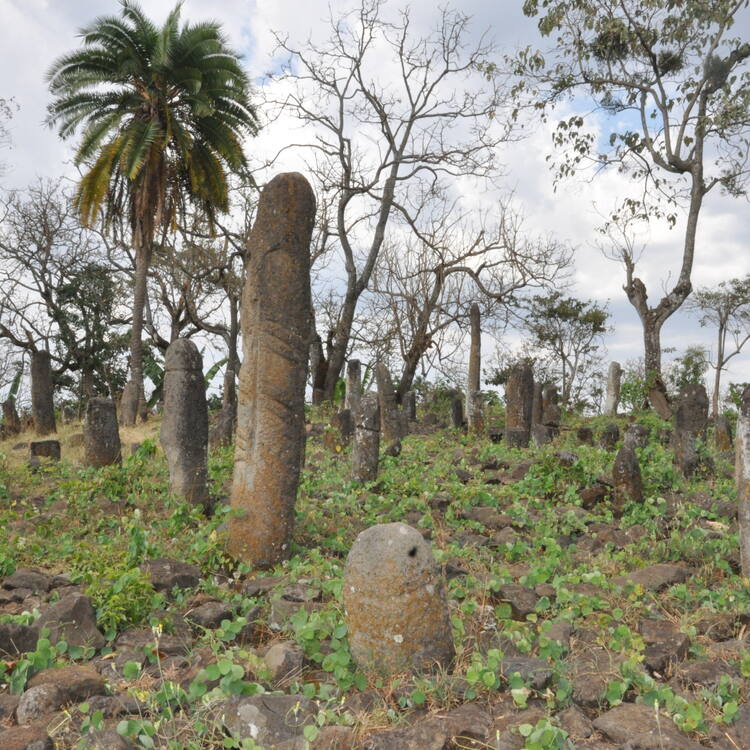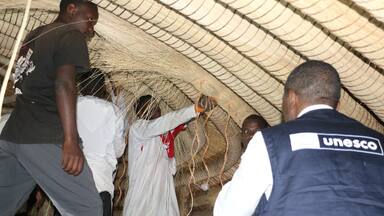The Gedeo Cultural Landscape
The Gedeo Cultural Landscape
Description is available under license CC-BY-SA IGO 3.0
Le paysage culturel du pays gedeo
Description is available under license CC-BY-SA IGO 3.0
منظر جيديو الطبيعي الثقافي
source: UNESCO/CPE
Description is available under license CC-BY-SA IGO 3.0
盖德奥文化景观
source: UNESCO/CPE
Description is available under license CC-BY-SA IGO 3.0
Культурный ландшафт Гедео
source: UNESCO/CPE
Description is available under license CC-BY-SA IGO 3.0
Paisaje cultural del país gedeo
source: UNESCO/CPE
Description is available under license CC-BY-SA IGO 3.0
Outstanding Universal Value
Brief synthesis
The Gedeo Cultural Landscape spread along the eastern escarpment of the Ethiopian highlands, is an exceptional testimony to a long-standing and still living indigenous Gedeo cultural tradition of agroforestry, with its layered cultivation of mature trees providing shelter for enset, coffee and other food crops. This symbiotic system, linking culture and nature, is underpinned by traditional knowledge systems of the Gedeo community, and has the capacity to sustain livelihoods while ensuring environmental sustainability.
The abundant alluvial rivers and fertile soils of the escarpment support the agroforestry layers spread over the twenty kilometres that separate the top of the escarpment from the lowlands. Large trees shelter indigenous enset – (enset ventricosum) the main food crop under which coffee grows, and now the main cash crop – together with other indigenous trees, root crops, shrubs, etc., each species occupying a distinct layer. The Gedeo Cultural Landscape property is home to just over a quarter of a million Gedeo people.
While the Gedeo are Indigenous to Ethiopia and have been associated with the cultivation of enset for perhaps a few thousand years, oral traditions suggest that they moved to the southwest from the north sometime during the last two millennia. The Gedeo communities are still largely guided by indigenous knowledge, and traditional institutions including the Songo, or Council of elders, as well as the Ballee system that regulates interaction with nature. Parts of the natural forest are set aside as sacred areas for ritual purposes, where no trees are felled or cultivation practised, and where indigenous tree species and medicinal plants have been preserved, while on the mountain ridges dense clusters of megalithic monuments, some steles and others in phallic form, were also revered by the Gedeo and cared for by their elders. The Gedeo traditional systems and practices underpin the forest regimes.
Criterion (iii): The Gedeo Cultural Landscape is an exceptional testimony to the long-standing and still living indigenous Gedeo cultural tradition of agroforestry with its layered cultivation of mature trees providing shelter for enset, and more recently coffee as well as shrubs and other food crops. For centuries, or perhaps even millennia, in what is now the southwest of Ethiopia, these traditional agroforestry practices have provided a sustainable living for communities, based on traditional knowledge and belief systems that reserved certain parts of the forest as sacred areas and protected megalithic clusters of steles as ritual sites.
Criterion (v): The Gedeo Cultural Landscape is as an outstanding example of how communities over time have devised systems to optimising the constraints and opportunities of their natural environment. The Gedeo indigenous Ballee system combines customary laws, rules, regulations, norms, and codes of social relations to govern interactions with nature. The resulting landscape not only supports the highest density of population in Africa, but it also maintains harmony with species, rich biodiversity and produces high quality organic coffee. It is though highly vulnerable to a range of social and economic pressures that are threatening its resilience and sustainability.
Integrity
The key attributes are present within the boundaries, though some of the landscape areas immediately beyond the boundaries may also include some attributes. The overall ensemble of attributes is extremely vulnerable to a large number of social and economic pressures. Although traditional management underpins the management of the property, the Ballee and Songo institutions that govern management are no longer adhered to by all community members which means that the traditional processes that support the overall layered agroforestry practices have been weakened. This could result in systemic collapse. In order for the Gedeo cultural landscape to survive in a sustainable form and to keep its value, the whole network of attributes that convey the Outstanding Universal Value must be sustained as a single integrated system. Urgent measures are needed to support and strengthen the traditional framework, as part of a wider strategic approach to development, in order to address the extreme vulnerability of integrity.
Authenticity
Traditional agroforestry practices and governance underpin and shape the whole Gedeo cultural landscape. The attributes are all interlinked and vulnerability of one part of the system can lead to vulnerability of the whole property. Thus, how well the agroforestry landscape conveys its value depend on the resilience of the traditional processes. The traditional practices and governance still persist but have been weakened and are extremely vulnerable to a host of different economic and social factors, which means that their ability to reflect meaning is compromised to a degree. Authenticity is thus highly vulnerable. If authenticity is to persist, and if the overall landscape is to reflect its meaning truthfully and credibly in the long term, traditional practices and traditional governance both need strengthening and supporting as a matter of urgency, in order to address the extreme vulnerability of authenticity.
Protection and management requirements
The status and protection of traditionally used land by local communities is enshrined in the Ethiopian Constitution. At the federal level, the Research and Conservation of Cultural Heritage Proclamation (209/2000) recognises the value and heritage status of a property that describes and witnesses the evolution of nature and which has a major value in its scientific, historical, cultural, artistic and handicraft content. This general protection for cultural aspects of the property is augmented by more local instruments that address the specificities of protecting the overall Gedeo cultural landscape.
The two key local instruments that were adopted by the Southern Nations, Nationalities and Peoples’ Region are: 1) The Southern Nations, Nationalities and Peoples’ Region Rural Land Administration and Utilization Proclamation (110/2007), that states that “land for communal use which includes social and cultural affairs and religion is reserved for the communities”; and 2) the Proclamation for Conservation and Protection of South Nations, Nationalities and Peoples’ Region State Cultural Landscape Heritages of Gedeo (189/2021). This second Proclamation is specific to the property and covers heritage sites, sacred sites and agroforestry which is defined as a “land management system for the cultivation and use of a wide range of valuable tree species, animals, combined with annual and permanent crops”. It also sets out the management structure and operational mechanisms that will translate its clauses into practice within the property, including constraints on where crops are planted, and support for traditional practices. The scope and details of the landscape to be protected will be determined by directives, and both Ethiopian and foreign universities are to be encouraged to undertake research and documentation to underpin these directives. These will need to define the traditional agroforestry of the property both generally and for specific areas as well as the limits of cultivation.

